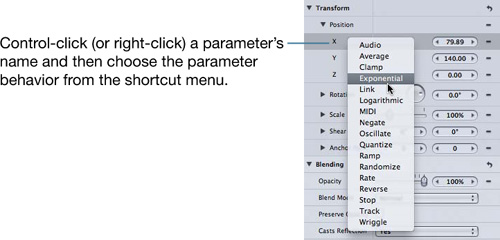7. Behaviors
Behaviors are primarily used to animate objects. When you want to fade in an object, move a camera along a path, or animate text, behaviors allow you to do these things (and many others) without setting keyframes.
In a nutshell, there are two behavior types: “regular” and parameter. Regular behaviors (usually referred to simply as behaviors) can affect one or many parameters of an object. Parameter behaviors are applied to a single object parameter and, therefore, affect only that parameter.
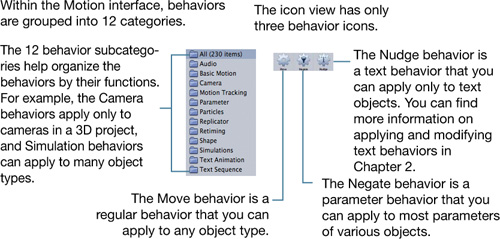
Applying Behaviors
You have several methods for applying behaviors. This first method allows you to preview the various behaviors.
- In the Layers tab or Canvas, select the destination object.
- In the Inspector tab, select a behavior.
- Apply the behavior using one of these options:
• Click the Apply button at the top of the Inspector.
• Drag the behavior to the destination object in the Layers tab or Canvas.
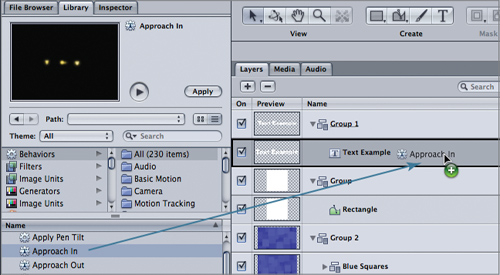
When you know which behavior you need, the following method provides quick access using the toolbar.
- Select the destination object.
- From the Behaviors pop-up menu in the Toolbar, choose the desired behavior.

Modifying Behaviors
After you’ve applied a behavior, you may need to tweak its settings. You’ll find the parameters of the selected behavior in the Behaviors tab of the Inspector and in the HUD.
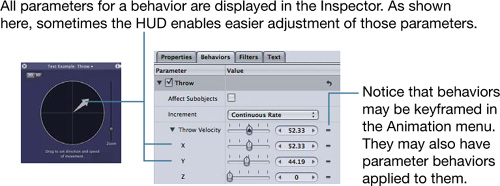
You can move or duplicate a behavior from one object to another.
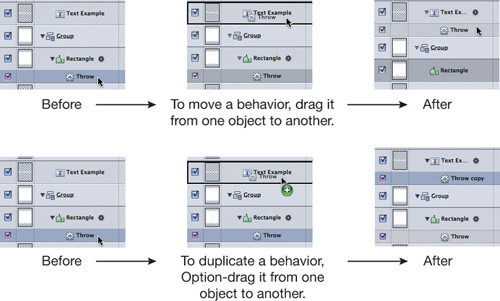
You can adjust a behavior’s timing and duration in the mini-Timeline or Timeline, just as you would modify other objects.
To change a behavior’s duration:
- Place the Select/Transform tool on the behavior’s In or Out point.
- Drag the point to change the duration.
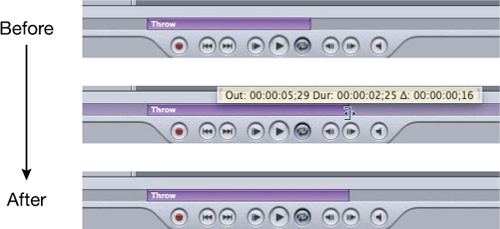
To alter the timing of a behavior relative to the applied object:
- Place the Select/Transform tool in the middle of the behavior.
- Drag to change the behavior’s timing.

Example Behaviors
In this section, you’ll examine examples of some specific behavior uses. (You will also find behaviors specific to text, shapes, paint strokes, particle systems, and replicators in their respective chapters of this book.)
Retiming
Several Retiming behaviors are available in Motion. They allow you to create flash frames, perform looped playback, and strobe and stutter clip playback. Set Speed is one Retiming behavior that allows you to create ramped speed effects within a clip.
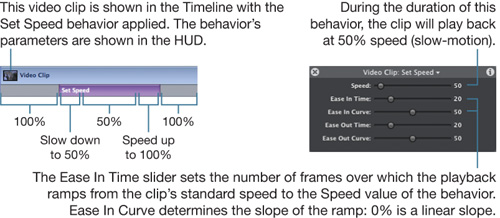
Tracking
Tracking is a variant of the behaviors that, by themselves, do not “do” something to a video object. Instead, Tracking creates motion data about every pixel, such as determining where a pixel went from one frame to the next. This data may then be used to “attach” other objects such as graphics.
- After applying the Tracking behavior, drag the default tracker to the video pixel you want to track.
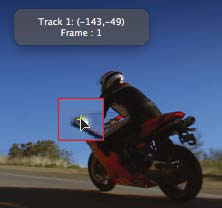
- If necessary, trim the behavior to the duration you need to track.
- Before clicking Analyze, you can add another tracker by clicking Add.

After analyzing the video, you will apply another behavior, Match Move, to a second object.
- Apply Match Move to the “follow” object.
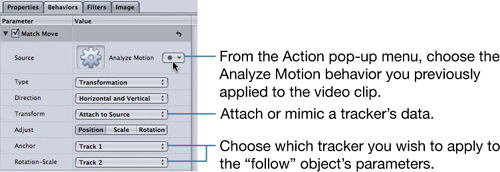
Stabilizing and Unstabilizing
As you can guess, these two behaviors do what their names imply. The Stabilize behavior can self-analyze a video clip or use tracker/tracker data to remove unwanted movement. The Unstabilize behavior can match new elements to original camera movement in a video clip. You must use tracker data created by another behavior (such as the Analyze Motion behavior) as the source of the camera movement.
Applying Parameter Behaviors
In addition to dragging parameter behaviors to apply them (as you would a regular behavior), you can also use the shortcut menus.
Modifying Parameter Behaviors
Parameter behaviors appear in the Inspector’s Behaviors tab. They are modified just like regular behaviors but have one special parameter: Apply To.
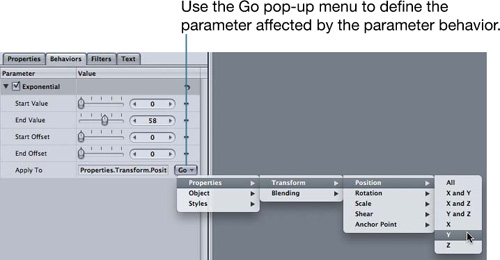
Example Parameter Behaviors
This section explores a few of the available parameter behaviors. See the Motion 4 User Manual for more information on all of the parameter behaviors.
Audio
The Audio parameter behavior allows you to animate an object’s parameters according to the frequencies and amplitudes of an audio file.
- Add an audio file to the project.
- Select the object/group to be animated.
- Control-click the parameter to be animated and choose Audio from the shortcut menu.
- In the Behaviors tab of the Inspector, locate the Audio behavior you just added.
- From the Source Audio To pop-up menu, choose the audio file to animate the parameter.
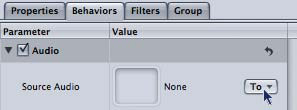
- Adjust the parameters as desired.
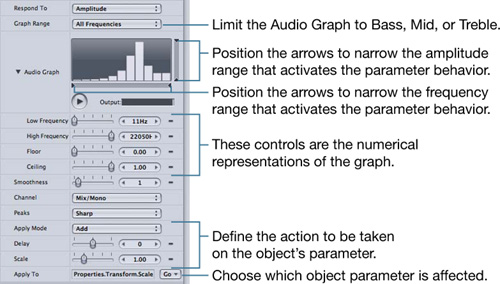
Link
When you need to animate one object in relation to another object’s animation, the Link behavior can save you time and frustration. In essence, you are linking the behaviors applied to a parameter of one object to the same or even a different parameter of another object.
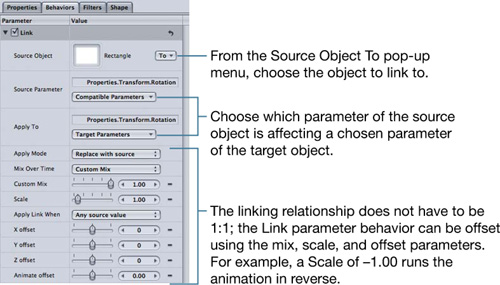
Wriggle
It may have a funny name, but when you just need an object to jiggle, Wriggle is your go-to behavior.
- Control-click a parameter to be animated and choose Wriggle from the shortcut menu.
- In the Behaviors tab of the Inspector, adjust the parameters as desired.
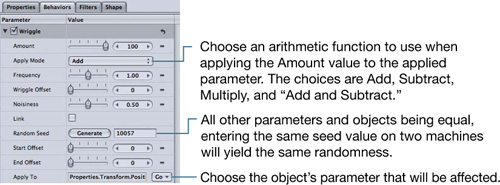
The following figure illustrates the result of the Wriggle behavior applied to an object’s Position parameter.


